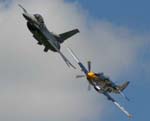A few weeks ago we loaded the car and joined the crowds at the airport in Janesville, Wisconsin for a summertime favorite, the air show.
 It featured the usual fare, with daring wing walkers and highly skilled aerobatic pilots gaining loud applause. There was even a "reenactment" of battle in Vietnam, complete with flying military aircraft of the period and a group of teenagers dressed up in (politically incorrect?) black pajamas carrying AK47 look-alikes serving as targets for "our boys."
It featured the usual fare, with daring wing walkers and highly skilled aerobatic pilots gaining loud applause. There was even a "reenactment" of battle in Vietnam, complete with flying military aircraft of the period and a group of teenagers dressed up in (politically incorrect?) black pajamas carrying AK47 look-alikes serving as targets for "our boys."
The real crowd-pleasers, as usual, were the modern military aircraft flown by active-duty servicemen. This show featured an act by an F/A-18 and one by an F-16, the latter of which also flew in (U.S. government-sanctioned) formation with a restored P-51 Mustang from WWII. They were beautiful displays and you could see the thrill on everyone’s face when those unimaginably powerful planes roared over the runway.
 This vision came back to me while watching Why We Fight this past weekend on DVD. The film’s director, Eugene Jarecki, asks from where in the U.S. comes the impetus to fight wars in the modern age, and his film includes footage from air shows where spectators’ faces mirrored the same awe I witnessed in person just a couple Sundays past.
This vision came back to me while watching Why We Fight this past weekend on DVD. The film’s director, Eugene Jarecki, asks from where in the U.S. comes the impetus to fight wars in the modern age, and his film includes footage from air shows where spectators’ faces mirrored the same awe I witnessed in person just a couple Sundays past.
Air shows serve three functions, all of which trouble me deeply even as I enjoy the spectacle. First, they are truly the Roman Circuses of our modern empire, binding citizens into the fabric of the nation’s militarism and helping them accept the staggering though largely unseen burden of paying for the world’s most technologically sophisticated and exotic mass death machines. Second, self-identified as part of the fabric of the nation’s might, the citizen is inoculated against criticism of political leaders and is more likely to become a supporter of war and militarism. Thus do we all fall under the spell of war, because we know in our hearts that we are not evil, and therefore our actions and the actions of our countrymen and leaders must be good.
Third, the show is part of the massive PR and recruitment budget for the military services, made fact by the highly visible presence of recruiters for all four branches. Watching Jarecki’s scenes of a directionless young man’s Army recruitment, with the boy’s pathetic description of his life and his naïve trust in the promise of a future piloting high-tech helicopters, is a perfectly tragic counterpoint to the (thankfully rare) scenes of corpses piled in Iraqi morgues.
Jarecki shows us how entrenched is this parasite in the society of the United States. The military-industrial complex has embedded itself such that, like a tumor buried deep in the brain, it is impossible to surgically remove any part of it without paralyzing U.S. society (or at least Congress). Congressmen would be as likely to shut down the Social Security Administration.
Historians will someday judge our nation harshly. Evaluated by budget priorities, the main business of the U.S. now is exporting death and destruction while a mythology of good intentions and American Exceptionalism lets citizens, corporate officers, and political leaders rationalize their participation in gross evil as benevolence and righteous self-defense.
 Why We Fight offers no easy answers or forecasts. Busts inevitably follow booms, however. From this we can deduce that the Great Credit Pyramid built during past decades has created unsustainable trends in the military-industrial complex just as it has in other parts of the U.S. economy, and when the turn comes an opportunity will occur. The challenge will be to resist the urge to turn economic turmoil toward greater war and conflict. Therein lies hope to dislodge militarism from its central role in American industry and society and reverse their otherwise inevitable slide ever further into evil.
Why We Fight offers no easy answers or forecasts. Busts inevitably follow booms, however. From this we can deduce that the Great Credit Pyramid built during past decades has created unsustainable trends in the military-industrial complex just as it has in other parts of the U.S. economy, and when the turn comes an opportunity will occur. The challenge will be to resist the urge to turn economic turmoil toward greater war and conflict. Therein lies hope to dislodge militarism from its central role in American industry and society and reverse their otherwise inevitable slide ever further into evil.
Since peace is usually unfashionable in tough times, we advocates of nonviolence have our work cut out for us. Maybe then we’ll let our convictions guide our actions.
July 6, 2006
David Calderwood [send him mail] a businessman, artist, and author of the novel Revolutionary Language, selected January 2000 Freedom Book of the Month at Free-market.net.




